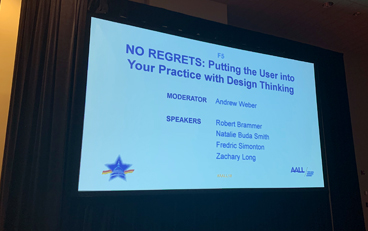
As part of the AALL (American Association of Law Libraries) Conference on July 15, 2019 at the Washington Convention Center, the Congress.gov User Experience (UX) team, which Artemis Consulting is a part of, presented a talk titled, “NO REGRETS: Putting the User into Your Practice with Design Thinking.” We presented some of the main features of the Congress.gov site to a small group of about 30-40 law librarians and legal professionals. The purpose of the conference was to enable these professionals to network with colleagues and better learn what other law librarians are doing around the country with legislative data.
Our presentation primarily discussed how we use Design Thinking to make a user-centered website. Design Thinking is the creative problem-solving process we use at our client, the Library of Congress. The process requires one to empathize, define, ideate, prototype and test. We explained that Congress.gov took the place of a public legacy site, thomas.gov and an internal system used by Capitol Hill DC Staff. Dealing with two groups of users who have very different needs and desires, we had to engage directly with the user community to make Congress.gov a user-friendly site. We collaborated with stakeholders, obtained feedback from users and conducted user interviews to know first-hand how users interact with the site. The resulting site provides a combination of several different methods for searching congressional data and offers a separate layout for Hill Staffers.
Design Thinking is a modern UX technique used to improve understanding of users, and something we use in our methodology for UX improvement in modern sites. It involves UX principles such as personas, empathy map and scenario maps. To further explain Design Thinking, we had the audience participate in an activity. First, we had them pick a persona – facets of what they imagined a typical law librarian would be looking for when using Congress.gov. Then, they created an empathy map, which is a chart listing all the things that particular persona may think, feel, say and do. Lastly, they created a scenario map, which captures how they might use Congress.gov, any frustrations they might have, and any features that might be useful to add.
During the debrief from our audience participation results, we learned some interesting information. In one instance, the user tried to search the site by using a member’s nickname, and it didn’t work. They tried searching for Bernie Sanders, instead of Bernard Sanders. We took the feedback and are already working on a way of making it possible for nicknames to return results for congressional members on the website.
Overall, our team was able to provide the audience with a good understanding of Design Thinking, its principles and applicability. By considering the process from the viewpoint of a user, the audience learned how they can make sure their clients are given the best experience. Although we only had an hour to discuss a process that would normally take months, it gave them some ideas on conducting more user research by putting users’ needs first.
Artemis Consulting uses this and other modern UX techniques on many of our projects. We try to be at the forefront of User experience and Citizen Experience, and incorporate the latest techniques into our thought process and iterative design philosophy.
